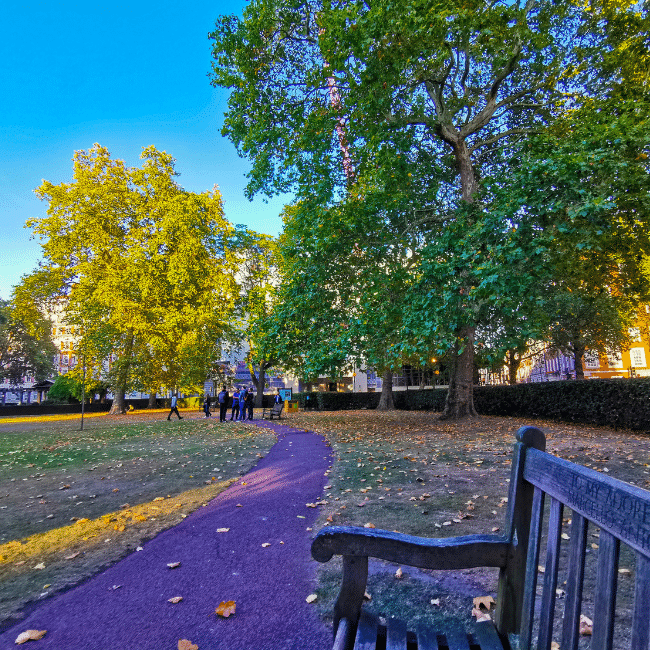Most Expensive Streets In London: New Top 10
Central London's luxury property market operates at a scale that sets it apart from almost any other city in the world. In an exclusive analysis of property transactions from January 2020 to January 2025, we reveal central London's richest and most expensive streets, record-breaking sales, and the locations driving the highest total values.
The findings paint a fascinating picture of London's ultra-prime property landscape, from a £100 million-plus property in Mayfair to historic mansions in Chelsea, showing how different streets compete for the title of London's most valuable addresses.
By examining the market through three different lenses - average street prices (to reveal the most expensive), individual record sales on each road (to show the new outliers), and total street values (to uncover the most active high value locations) - we uncover patterns that highlight both the concentration of wealth in traditional prime areas and the emergence of new luxury property hotspots.
These streets maybe out of reach for the average London buy-to-let investor, yet they are popular amongst London's millionaire and billionaire property buyers.
Through our analysis of over 15,000 transactions, we explore how historic squares like Grosvenor Square compete with traditional mansion streets like The Boltons, and how new luxury developments are reshaping the definition of prime central London property and billionaire rows.
For an alternate look at London's property market you can see our research in to the cheapest areas to live in London here.
Data updated: January 2025. Next update: April 2025

-
by Robert Jones, Founder of Property Investments UK
With two decades in UK property, Rob has been investing in buy-to-let since 2005, and uses property data to develop tools for property market analysis.
Property Data Sources
Our highest house prices and streets guide relies on diverse, authoritative datasets including:
We update our property data quarterly to ensure accuracy. Last update: January 2025. Next update: April 2025. All data is presented as provided by our sources without adjustments or amendments.

Top 10 Most Expensive Streets in London
Updated January 2025
Date range: 1st January 2020 to latest dates available on land registry price sold data at the time of research.
| # | Street Name | Postcode | Average Price | Transactions |
|---|---|---|---|---|
| 1 | THE BOLTONS | SW10 | £32,583,333 | 3 |
| 2 | UPPER PHILLIMORE GARDENS | W8 | £22,478,984 | 4 |
| 3 | WHITEHALL PLACE | SW1A | £20,125,000 | 2 |
| 4 | COTTESMORE GARDENS | W8 | £19,362,500 | 4 |
| 5 | GLEBE PLACE | SW3 | £18,345,000 | 12 |
| 6 | CLEVELAND ROW | SW1A | £17,500,000 | 3 |
| 7 | KENSINGTON ROAD | W8 | £16,800,000 | 3 |
| 8 | PHILLIMORE GARDENS | W8 | £16,731,068 | 11 |
| 9 | ASHBURTON PLACE | W1J | £16,087,055 | 5 |
| 10 | GROSVENOR SQUARE | W1K | £15,177,640 | 119 |
Note: Only streets with multiple property transactions during this period are included in this table.
The ranking of London's most expensive streets by average price reveals a fascinating concentration of wealth in specific neighborhoods. The Boltons in the Boltons Conservation Area (SW10) stands out as London's most expensive street during the past few years with an average price of £32.5 million - significantly higher than its nearest competitor. This figure is particularly notable as it's based on three separate transactions, suggesting consistent ultra-prime valuations rather than a single outlier sale.
Kensington's dominance in London's rich super-prime market is evident, with four W8 addresses in the top 10: Upper Phillimore Gardens (£22.4M), Cottesmore Gardens (£19.3M), Kensington Road (£16.8M), and Phillimore Gardens (£16.7M). This concentration highlights Kensington's enduring appeal to ultra-high-net-worth buyers, particularly around the Phillimore Estate area (Phillimore Estate history).
Perhaps the most intriguing entry is Grosvenor Square, which combines an impressive average price of £15.1 million with an extraordinary 119 transactions. This volume of sales - far exceeding any other street in the top 10 - reflects both the square's large number of luxury apartments and its status as Mayfair's premier address. Most other streets in the ranking show typically low transaction volumes (2-5 sales), highlighting the exclusive nature of these addresses.

London's Highest Individual Property Sales
Updated January 2025
Date range: 1st January 2020 to latest dates available on land registry price sold data at the time of research.
| # | Street Name | Postcode | Sale Price | Date |
|---|---|---|---|---|
| 1 | GROSVENOR SQUARE | W1K 4BN | £110,900,000 | 16 Oct 2020 |
| 2 | NEW BOND STREET | W1S 4RH | £82,000,000 | 8 May 2024 |
| 3 | OLD CHURCH STREET | SW3 5BY | £73,200,000 | 6 Mar 2023 |
| 4 | GLEBE PLACE | SW3 5JP | £68,250,000 | 18 Oct 2023 |
| 5 | GROSVENOR SQUARE | W1K 4AB | £65,670,000 | 18 Aug 2022 |
| 6 | STANHOPE GATE | W1K 1AH | £60,000,000 | 25 May 2022 |
| 7 | GROSVENOR SQUARE | W1K 6US | £56,127,841 | 31 May 2024 |
| 8 | GROSVENOR STREET | W1K 3JP | £56,000,000 | 21 Dec 2021 |
| 9 | GLEBE PLACE | SW3 5JP | £55,050,000 | 8 Sep 2022 |
| 10 | GROSVENOR SQUARE | W1K 4AB | £53,360,000 | 18 Aug 2020 |
Note: This table includes all properties sold during this period, including streets with single transactions, to capture significant outlier sales.
London's highest individual property sales showcase the extraordinary upper limits of the capital's real estate market with record sales across a handful of roads in London. The top spot is claimed by a Grosvenor Square apartment at an astonishing £110.9 million, setting a benchmark that demonstrates Mayfair's position at the pinnacle of London's luxury property market.
The list reveals interesting geographical patterns, with Mayfair's Grosvenor Square featuring prominently with four entries in the top 10, including the record-breaking top sale. The most recent high-value transactions include New Bond Street at £82 million and another Grosvenor Square property at £56.1 million, both in May 2024, suggesting continued strength in the super-prime market.
Chelsea's emergence as a competing ultra-prime location is evidenced by two significant sales on Glebe Place (£68.2M and £55M) and Old Church Street (£73.2M). These sales are particularly notable as they represent some of the area's largest family homes, rather than the luxury apartments more commonly found in Mayfair.
The timing of these sales is particularly revealing. The spread of transactions from 2020 to 2024 demonstrates the resilience of London's ultra-prime market through various economic cycles, including the post-pandemic period. The fact that two of the ten highest sales occurred in 2024 suggests continued strong demand at the very top of the market.

Record Breaking Streets - Total Value of Property Sales
Updated January 2025
Date range: 1st January 2020 to latest dates available on land registry price sold data at the time of research.
| # | Street Name | Postcode | Total Value | Transactions |
|---|---|---|---|---|
| 1 | GROSVENOR SQUARE | W1K | £1,806,139,199 | 119 |
| 2 | PARK CRESCENT | W1B | £459,777,630 | 81 |
| 3 | MILLBANK | SW1P | £417,587,656 | 209 |
| 4 | PORTUGAL STREET | WC2A | £350,556,583 | 146 |
| 5 | ST JOHNS WOOD ROAD | NW8 | £313,866,234 | 168 |
| 6 | STANHOPE GATE | W1K | £304,835,000 | 27 |
| 7 | HORSE GUARDS AVENUE | SW1A | £296,559,498 | 31 |
| 8 | BARBICAN | EC2Y | £284,809,439 | 299 |
| 9 | HAMILTON TERRACE | NW8 | £226,206,959 | 48 |
| 10 | WATERFRONT DRIVE | SW10 | £221,824,130 | 141 |
Note: This table includes all properties sold during this period, including streets with single transactions, to capture significant outlier sales.
When analysing London's property market by total sales value, a dramatically different picture emerges from the average price rankings. Grosvenor Square stands in a league of its own with an extraordinary total of £1.8 billion in sales - nearly four times the value of its nearest competitor.
How to find the most expensive streets in London
Here is the step by step process we followed to get the data on all of the highest priced property sales and most expensive streets across the capital.
- Visit HM Land Registry price paid data set.
- Select your postcodes and property types (we choose all property types; detached, semi-detached, terraced and flat/maisonette. We missed 'other' as this often includes commercial properties and we are only looking for residential homes.
- Select your dates (we selected 01-01-2020 to the latest date available).
- The select how many results you would like. You can limit it to 100 for example. We selected 'All'
- Then download the data set and review for the highest sales
Note: Remember to remove duplicates as HM Land registry property transaction datasets can on occasion include duplicate listings and if these aren't removed it can skew the data especially for average property prices on specific streets where there are low transaction volumes.
You can of course do this for other postcode districts, towns and cities across England and Wales and we have done this for other areas around the country which you can find in our property research location datasets here.
Frequently Asked Questions
Q1). How often is this data updated?
HM Land Registry price paid data is updated on a monthly basis and has data available for individual property sales including the roads and postcodes since 1995. We aim to update our location research every three months and we provide a date stamp on each of our research articles so you can see when it was last updated.
This content and house price data was updated on this page January 2025.
Q2). Can I access the full list of sold transactions for every street?
Yes of course. You can get the full property sales transaction data directly from HM Land Registry here.
Q3). Are these prices for residential properties only?
Yes we aim to only include residential sales in this dataset. When you download sold house price data from HM Land Registry you can select a range of options including 'property types'. We have included detached houses, semi-detached houses, terraced houses and flat / maisonette in this data.
Q4). Does this property data include ALL sales?
Yes. Whenever a property is sold in England and Wales it is recorded at HM Land Registry. This dataset for the most expensive streets comes directly from sold house price data provided by HM Land Registry. This is provided free of charge under the Open Government Licence.
